Abstract
The most common cause of late death following trauma is sepsis. The traumatized patient has a significant increased risk of infection. Transfusion, hypotension, and prolonged ventilatory support are predictive of septic complications. In addition, the trauma patient has a higher predisposition to pneumonia than nontrauma patients (18% versus 3% incidence of pneumonia, P < .001). Additional risk factors include the degree of nutrition status and the type of medications used during surgery. Immunologic depression may be an additional risk factor. There is mounting evidence that trauma can result in host defense abnormalities. To prevent the significant mortality caused by sepsis, close surveillance must be maintained, nutritional status must be optimal, and liberal use of antibiotics should be discouraged. Their use should be guided by appropriate cultures and sensitivities.
Full text
PDF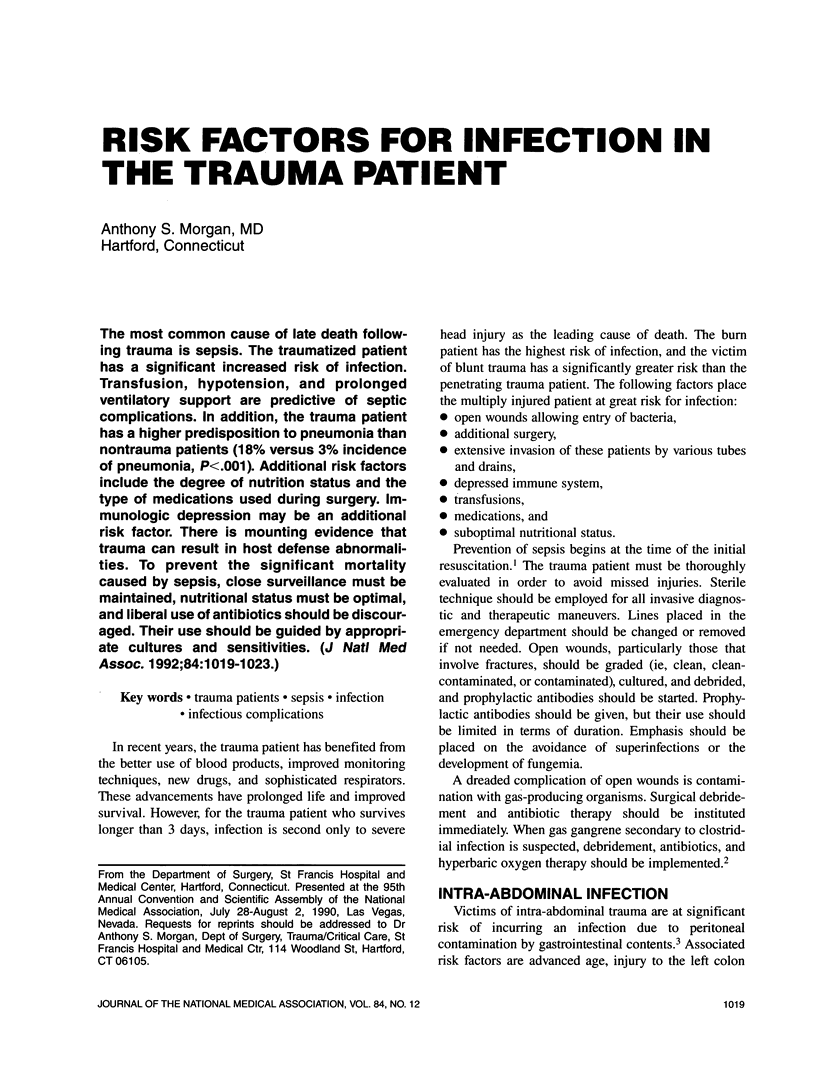
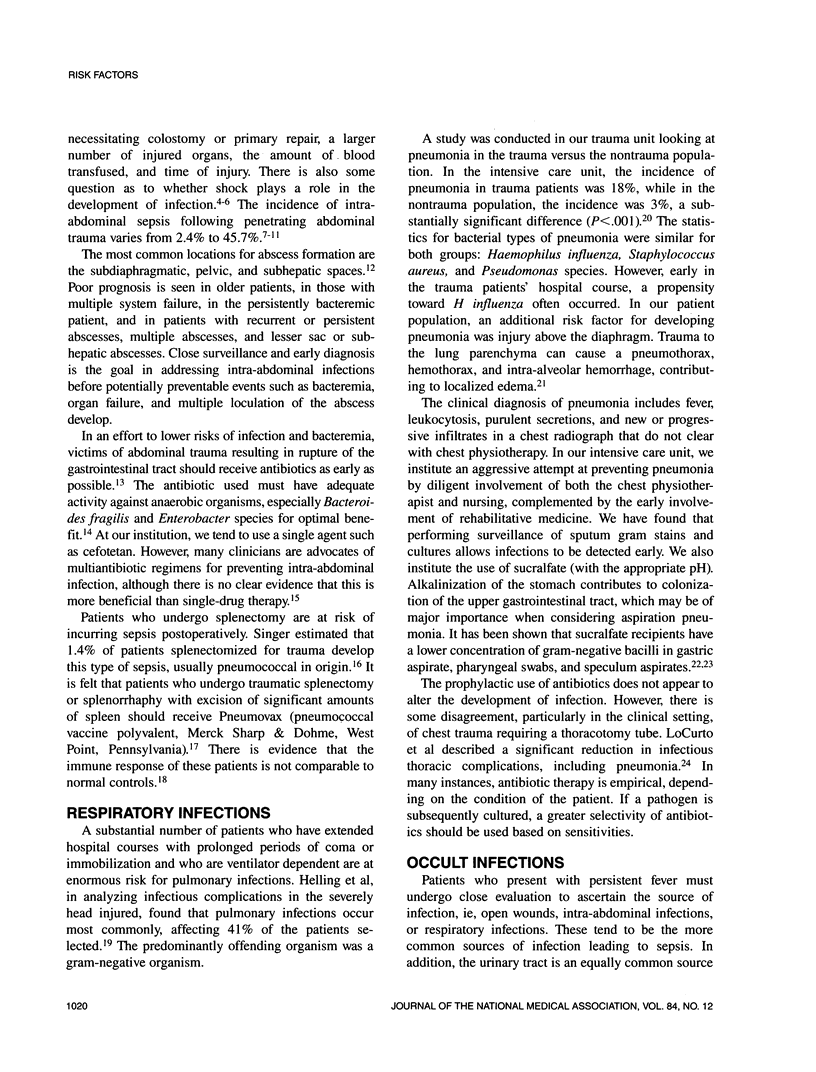
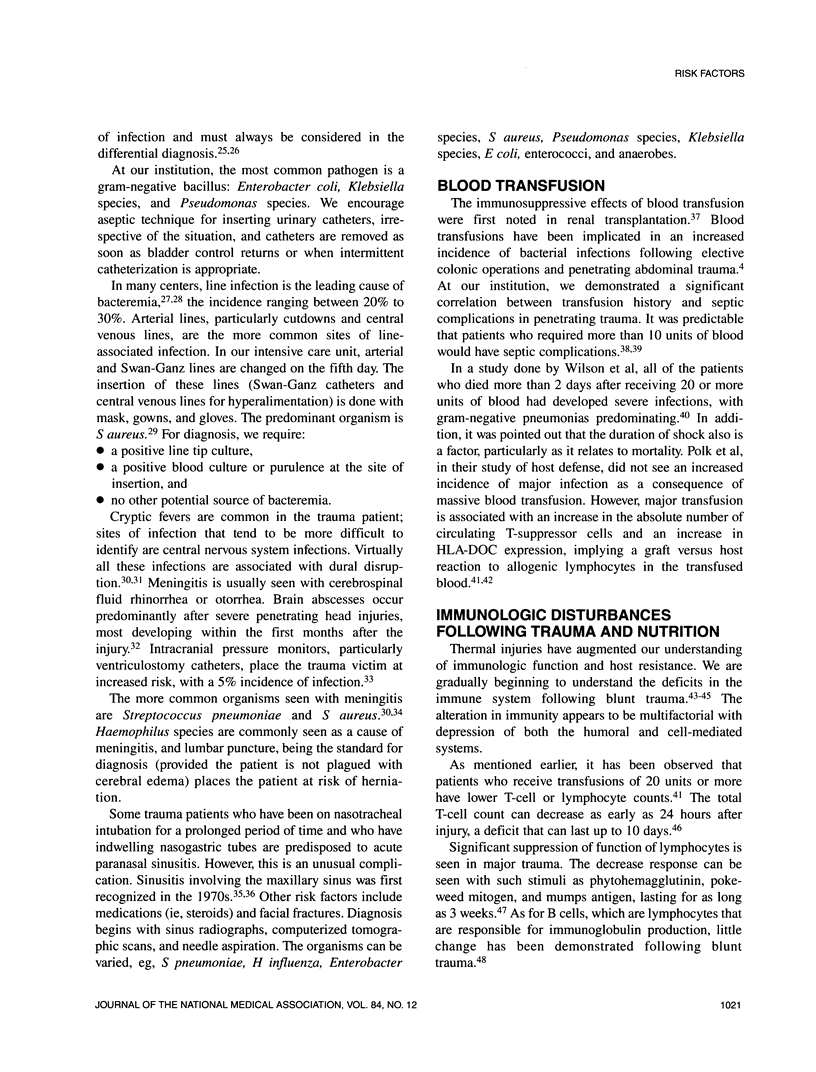
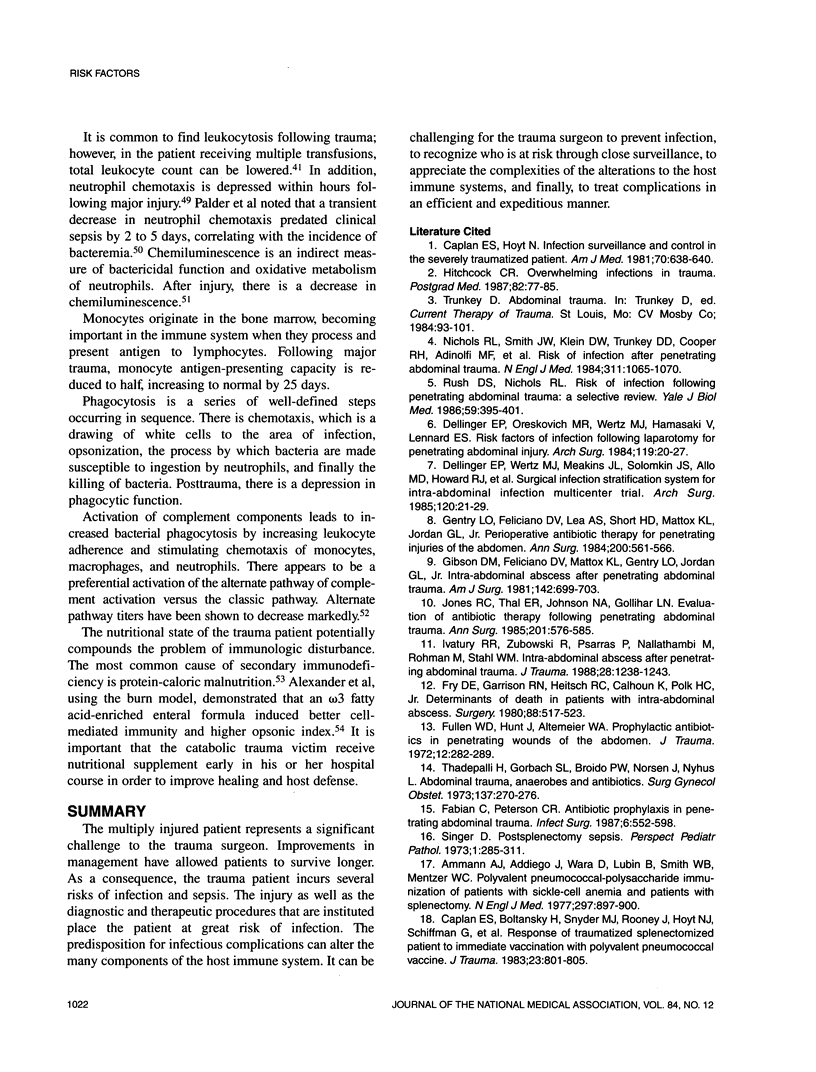
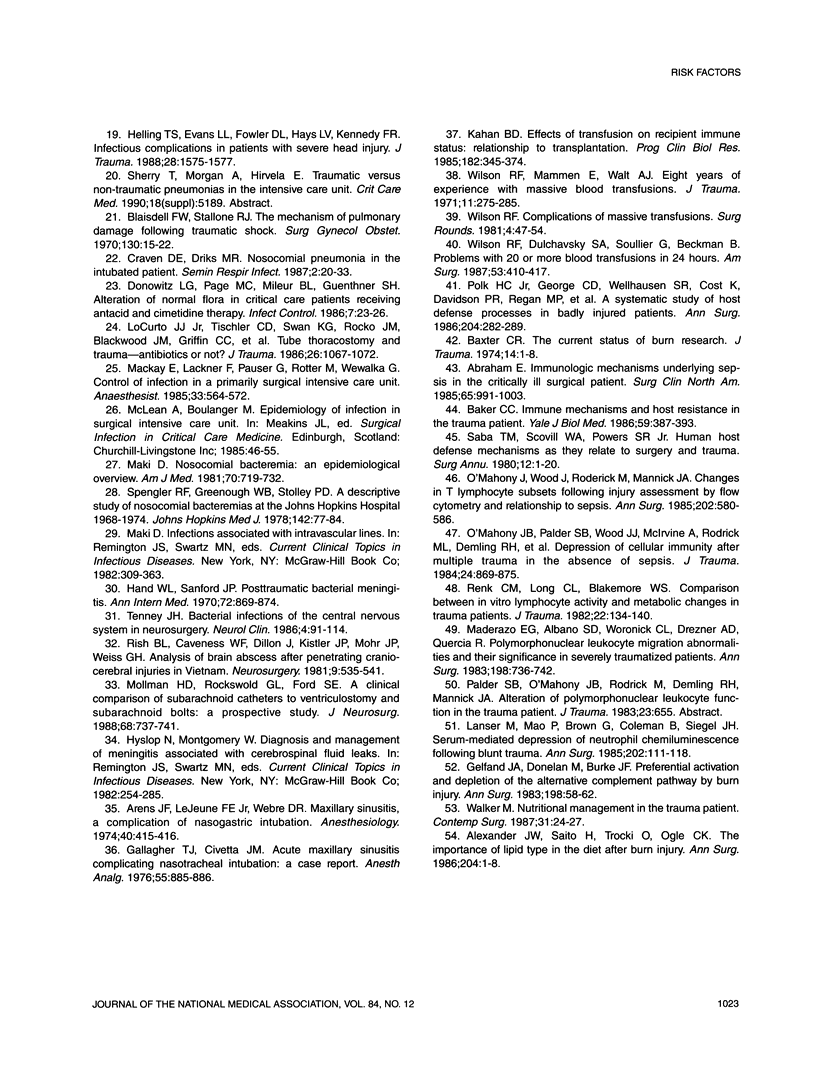
Selected References
These references are in PubMed. This may not be the complete list of references from this article.
- Abraham E. Immunologic mechanisms underlying sepsis in the critically ill surgical patient. Surg Clin North Am. 1985 Aug;65(4):991–1003. doi: 10.1016/s0039-6109(16)43690-x. [DOI] [PubMed] [Google Scholar]
- Alexander J. W., Saito H., Trocki O., Ogle C. K. The importance of lipid type in the diet after burn injury. Ann Surg. 1986 Jul;204(1):1–8. doi: 10.1097/00000658-198607000-00001. [DOI] [PMC free article] [PubMed] [Google Scholar]
- Ammann A. J., Addiego J., Wara D. W., Lubin B., Smith W. B., Mentzer W. C. Polyvalent pneumococcal-polysaccharide immunization of patients with sickle-cell anemia and patients with splenectomy. N Engl J Med. 1977 Oct 27;297(17):897–900. doi: 10.1056/NEJM197710272971701. [DOI] [PubMed] [Google Scholar]
- Arens J. F., LeJeune F. E., Jr, Webre D. R. Maxillary sinusitis, a complication of nasotracheal intubation. Anesthesiology. 1974 Apr;40(4):415–416. doi: 10.1097/00000542-197404000-00024. [DOI] [PubMed] [Google Scholar]
- Baker C. C. Immune mechanisms and host resistance in the trauma patient. Yale J Biol Med. 1986 Jul-Aug;59(4):387–393. [PMC free article] [PubMed] [Google Scholar]
- Baxter C. R. The current status of burn research. J Trauma. 1974 Jan;14(1):1–8. [PubMed] [Google Scholar]
- Blaisdell F. W., Stallone R. J. The mechanism of pulmonary damage following traumatic shock. Surg Gynecol Obstet. 1970 Jan;130(1):15–22. [PubMed] [Google Scholar]
- Caplan E. S., Boltansky H., Snyder M. J., Rooney J., Hoyt N. J., Schiffman G., Cowley R. A. Response of traumatized splenectomized patients to immediate vaccination with polyvalent pneumococcal vaccine. J Trauma. 1983 Sep;23(9):801–805. doi: 10.1097/00005373-198309000-00005. [DOI] [PubMed] [Google Scholar]
- Caplan E. S., Hoyt N. Infection surveillance and control in the severely traumatized patient. Am J Med. 1981 Mar;70(3):638–640. doi: 10.1016/0002-9343(81)90587-8. [DOI] [PubMed] [Google Scholar]
- Craven D. E., Driks M. R. Nosocomial pneumonia in the intubated patient. Semin Respir Infect. 1987 Mar;2(1):20–33. [PubMed] [Google Scholar]
- Dellinger E. P., Oreskovich M. R., Wertz M. J., Hamasaki V., Lennard E. S. Risk of infection following laparotomy for penetrating abdominal injury. Arch Surg. 1984 Jan;119(1):20–27. doi: 10.1001/archsurg.1984.01390130010002. [DOI] [PubMed] [Google Scholar]
- Dellinger E. P., Wertz M. J., Meakins J. L., Solomkin J. S., Allo M. D., Howard R. J., Simmons R. L. Surgical infection stratification system for intra-abdominal infection. Multicenter trial. Arch Surg. 1985 Jan;120(1):21–29. doi: 10.1001/archsurg.1985.01390250015003. [DOI] [PubMed] [Google Scholar]
- Donowitz L. G., Page M. C., Mileur B. L., Guenthner S. H. Alteration of normal gastric flora in critical care patients receiving antacid and cimetidine therapy. Infect Control. 1986 Jan;7(1):23–26. doi: 10.1017/s0195941700063748. [DOI] [PubMed] [Google Scholar]
- Fry D. E., Garrison R. N., Heitsch R. C., Calhoun K., Polk H. C., Jr Determinants of death in patients with intraabdominal abscess. Surgery. 1980 Oct;88(4):517–523. [PubMed] [Google Scholar]
- Fullen W. D., Hunt J., Altemeier W. A. Prophylactic antibiotics in penetrating wounds of the abdomen. J Trauma. 1972 Apr;12(4):282–289. doi: 10.1097/00005373-197204000-00003. [DOI] [PubMed] [Google Scholar]
- Gallagher T. J., Civetta J. M. Acute maxillary sinusitis complicating nasotracheal intubation: a case report. Anesth Analg. 1976 Nov-Dec;55(6):885–886. doi: 10.1213/00000539-197611000-00035. [DOI] [PubMed] [Google Scholar]
- Gelfand J. A., Donelan M., Burke J. F. Preferential activation and depletion of the alternative complement pathway by burn injury. Ann Surg. 1983 Jul;198(1):58–62. doi: 10.1097/00000658-198307000-00011. [DOI] [PMC free article] [PubMed] [Google Scholar]
- Gentry L. O., Feliciano D. V., Lea A. S., Short H. D., Mattox K. L., Jordan G. L., Jr Perioperative antibiotic therapy for penetrating injuries of the abdomen. Ann Surg. 1984 Nov;200(5):561–566. doi: 10.1097/00000658-198411000-00001. [DOI] [PMC free article] [PubMed] [Google Scholar]
- Gibson D. M., Feliciano D. V., Mattox K. L., Gentry L. O., Jordan G. L., Jr Intraabdominal abscess after penetrating abdominal trauma. Am J Surg. 1981 Dec;142(6):699–703. doi: 10.1016/0002-9610(81)90315-9. [DOI] [PubMed] [Google Scholar]
- Hand W. L., Sanford J. P. Posttraumatic bacterial meningitis. Ann Intern Med. 1970 Jun;72(6):869–874. doi: 10.7326/0003-4819-72-6-869-72-6-869. [DOI] [PubMed] [Google Scholar]
- Helling T. S., Evans L. L., Fowler D. L., Hays L. V., Kennedy F. R. Infectious complications in patients with severe head injury. J Trauma. 1988 Nov;28(11):1575–1577. doi: 10.1097/00005373-198811000-00009. [DOI] [PubMed] [Google Scholar]
- Hitchcock C. R. Overwhelming infections in trauma. Postgrad Med. 1987 Nov 1;82(6):77-9, 82, 84-5. doi: 10.1080/00325481.1987.11700030. [DOI] [PubMed] [Google Scholar]
- Ivatury R. R., Zubowski R., Psarras P., Nallathambi M., Rohman M., Stahl W. M. Intra-abdominal abscess after penetrating abdominal trauma. J Trauma. 1988 Aug;28(8):1238–1243. doi: 10.1097/00005373-198808000-00017. [DOI] [PubMed] [Google Scholar]
- Jones R. C., Thal E. R., Johnson N. A., Gollihar L. N. Evaluation of antibiotic therapy following penetrating abdominal trauma. Ann Surg. 1985 May;201(5):576–585. doi: 10.1097/00000658-198505000-00006. [DOI] [PMC free article] [PubMed] [Google Scholar]
- Kahan B. D. Effects of transfusion on recipient immune status: relationship to transplantation. Prog Clin Biol Res. 1985;182:345–374. [PubMed] [Google Scholar]
- Lanser M. E., Mao P., Brown G., Coleman B., Siegel J. H. Serum-mediated depression of neutrophil chemiluminescence following blunt trauma. Ann Surg. 1985 Jul;202(1):111–118. doi: 10.1097/00000658-198507000-00018. [DOI] [PMC free article] [PubMed] [Google Scholar]
- LoCurto J. J., Jr, Tischler C. D., Swan K. G., Rocko J. M., Blackwood J. M., Griffin C. C., Lazaro E. J., Reiner D. S. Tube thoracostomy and trauma--antibiotics or not? J Trauma. 1986 Dec;26(12):1067–1072. doi: 10.1097/00005373-198612000-00001. [DOI] [PubMed] [Google Scholar]
- Mackay E., Lackner F., Pauser G., Rotter M., Wewalka G. Infektionsüberwachung an einer vorwiegend chirurgischen Intensivbehandlungsstation. Anaesthesist. 1984 Nov;33(11):564–572. [PubMed] [Google Scholar]
- Maderazo E. G., Albano S. D., Woronick C. L., Drezner A. D., Quercia R. Polymorphonuclear leukocyte migration abnormalities and their significance in seriously traumatized patients. Ann Surg. 1983 Dec;198(6):736–742. doi: 10.1097/00000658-198312000-00012. [DOI] [PMC free article] [PubMed] [Google Scholar]
- Maki D. G. Nosocomial bacteremia. An epidemiologic overview. Am J Med. 1981 Mar;70(3):719–732. doi: 10.1016/0002-9343(81)90603-3. [DOI] [PubMed] [Google Scholar]
- Mollman H. D., Rockswold G. L., Ford S. E. A clinical comparison of subarachnoid catheters to ventriculostomy and subarachnoid bolts: a prospective study. J Neurosurg. 1988 May;68(5):737–741. doi: 10.3171/jns.1988.68.5.0737. [DOI] [PubMed] [Google Scholar]
- Nichols R. L., Smith J. W., Klein D. B., Trunkey D. D., Cooper R. H., Adinolfi M. F., Mills J. Risk of infection after penetrating abdominal trauma. N Engl J Med. 1984 Oct 25;311(17):1065–1070. doi: 10.1056/NEJM198410253111701. [DOI] [PubMed] [Google Scholar]
- O'Mahony J. B., Palder S. B., Wood J. J., McIrvine A., Rodrick M. L., Demling R. H., Mannick J. A. Depression of cellular immunity after multiple trauma in the absence of sepsis. J Trauma. 1984 Oct;24(10):869–875. doi: 10.1097/00005373-198410000-00001. [DOI] [PubMed] [Google Scholar]
- O'Mahony J. B., Wood J. J., Rodrick M. L., Mannick J. A. Changes in T lymphocyte subsets following injury. Assessment by flow cytometry and relationship to sepsis. Ann Surg. 1985 Nov;202(5):580–586. doi: 10.1097/00000658-198511000-00008. [DOI] [PMC free article] [PubMed] [Google Scholar]
- Polk H. C., Jr, George C. D., Wellhausen S. R., Cost K., Davidson P. R., Regan M. P., Borzotta A. P. A systematic study of host defense processes in badly injured patients. Ann Surg. 1986 Sep;204(3):282–299. [PMC free article] [PubMed] [Google Scholar]
- Renk C. M., Long C. L., Blakemore W. S. Comparison between in vitro lymphocyte activity and metabolic changes in trauma patients. J Trauma. 1982 Feb;22(2):134–140. doi: 10.1097/00005373-198202000-00010. [DOI] [PubMed] [Google Scholar]
- Rish B. L., Caveness W. F., Dillon J. D., Kistler J. P., Mohr J. P., Weiss G. H. Analysis of brain abscess after penetrating craniocerebral injuries in Vietnam. Neurosurgery. 1981 Nov;9(5):535–541. doi: 10.1227/00006123-198111000-00008. [DOI] [PubMed] [Google Scholar]
- Rush D. S., Nichols R. L. Risk of infection following penetrating abdominal trauma: a selective review. Yale J Biol Med. 1986 Jul-Aug;59(4):395–401. [PMC free article] [PubMed] [Google Scholar]
- Saba T. M., Scovill W. A., Powers S. R., Jr Human host defense mechanisms as they relate to surgery and trauma. Surg Annu. 1980;12:1–20. [PubMed] [Google Scholar]
- Singer D. B. Postsplenectomy sepsis. Perspect Pediatr Pathol. 1973;1:285–311. [PubMed] [Google Scholar]
- Spengler R. F., Greenough 3d W. B., Stolley P. D. A descriptive study of nosocomial bacteremias at The Johns Hopkins Hospital, 1968--1974. Johns Hopkins Med J. 1978 Mar;142(3):77–84. [PubMed] [Google Scholar]
- Tenney J. H. Bacterial infections of the central nervous system in neurosurgery. Neurol Clin. 1986 Feb;4(1):91–114. [PubMed] [Google Scholar]
- Thadepalli H., Gorbach S. L., Broido P. W., Norsen J., Nyhus L. Abdominal trauma, anaerobes, and antibiotics. Surg Gynecol Obstet. 1973 Aug;137(2):270–276. [PubMed] [Google Scholar]
- Wilson R. F., Dulchavsky S. A., Soullier G., Beckman B. Problems with 20 or more blood transfusions in 24 hours. Am Surg. 1987 Jul;53(7):410–417. [PubMed] [Google Scholar]
- Wilson R. F., Mammen E., Walt A. J. Eight years of experience with massive blood transfusions. J Trauma. 1971 Apr;11(4):275–285. doi: 10.1097/00005373-197104000-00001. [DOI] [PubMed] [Google Scholar]


